Yeah, I will have to (re)design some survey craft once the current situation is dealt with...
1900Colonies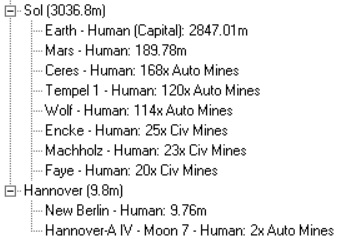 Earth
Earth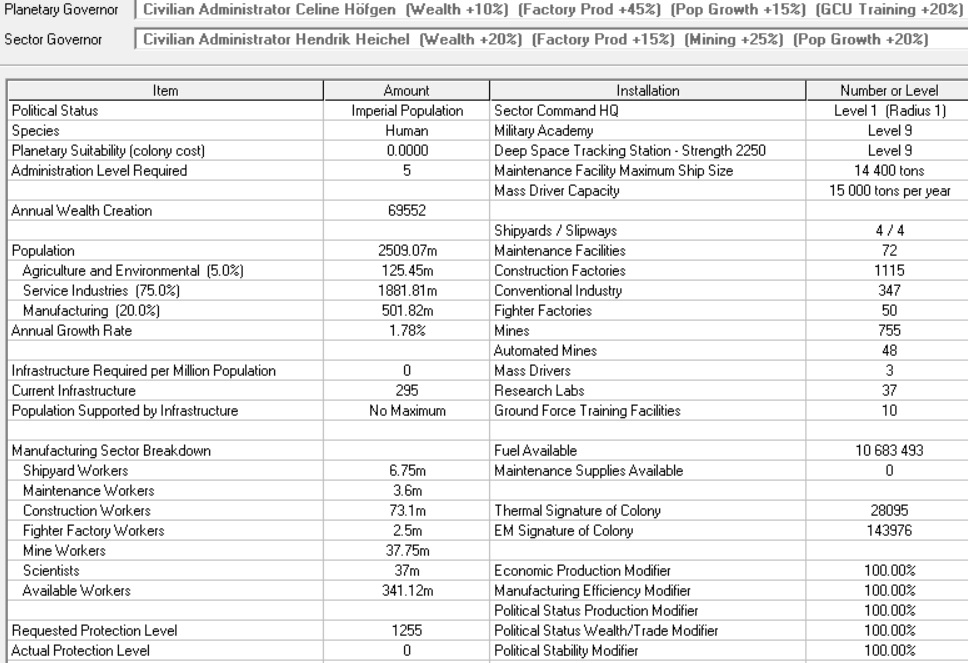 Minerals
Minerals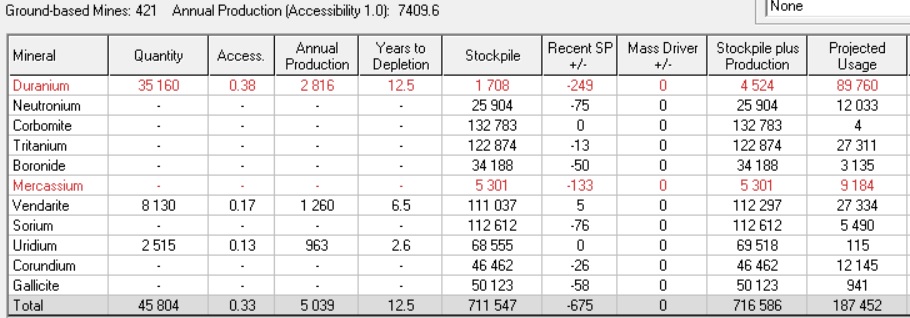 Shipyards
Shipyards Research
Research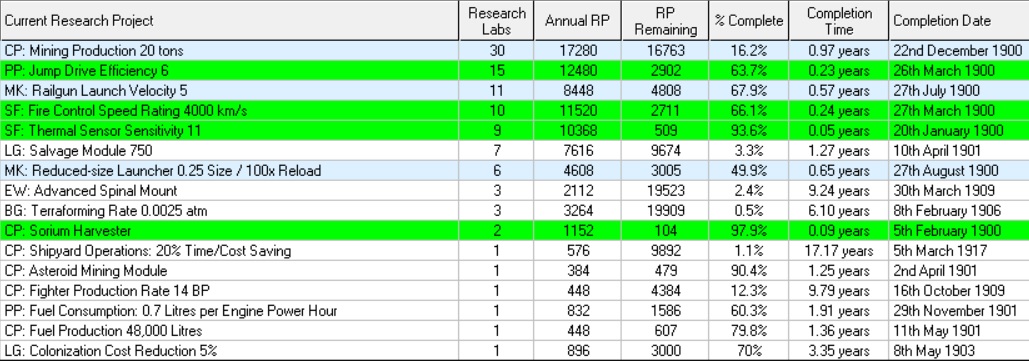
New Berlin will soon reach a population of 10 million and demand some form of protection. With the troop transports scheduled for refit and no military ships at all this will become a problem. The only alternative at the moment is a PDC which will be prefabricated on Earth and moved to New Berlin. The current design is more show than substance and nobody has to know that no missiles have been actually designed or build yet…
Flak class Point Defence Base 5 000 tons 186 Crew 663 BP TCS 100 TH 0 EM 0
Armour 6-26 Sensors 1/140 Damage Control Rating 0 PPV 52
Intended Deployment Time: 3 months Flight Crew Berths 1
Hangar Deck Capacity 1000 tons Magazine 52
Fuel Capacity 430 000 Litres Range N/A
PDC Size 1 Missile Launcher (52) Missile Size 1 Rate of Fire 15
Missile Fire Control FC3-R1 (5) Range 3.5m km Resolution 1
Active Search Sensor MR19-R1 (1) GPS 140 Range 19.6m km MCR 2.1m km Resolution 1
This design is classed as a Planetary Defence Centre and can be pre-fabricated in 2 sections
But the main problem is the Duranium crunch and while there are enough mines to deal with it in the long run it will be hard for a while. 54 automines will be moved from Wolf (Corundium) to Ceres (Duranium). It might get even harder considering the danger of meeting potentially hostile aliens. With the lack of minerals higher efficiency/tech are more important. Salvaging might help here – and with resources as well – but currently Humanity lacks a dedicated transport ship under direct control. There are two designs which should remedy this, but are partially limited by current shipyard capacity:
Esel class Freighter 30 000 tons 52 Crew 416.4 BP TCS 600 TH 600 EM 0
1000 km/s Armour 1-86 Shields 0-0 Sensors 1/1/0/0 Damage Control Rating 0 PPV 0
MSP 1 Max Repair 50 MSP
Intended Deployment Time: 36 months Spare Berths 0
Cargo 25000 Cargo Handling Multiplier 10
EP05 FC 08 25HS 200 EP Commercial Magneto-plasma Drive (3) Power 200 Fuel Use 10.61% Signature 200 Exp 5%
Fuel Capacity 430 000 Litres Range 24.3 billion km (281 days at full power)
This design is classed as a Commercial Vessel for maintenance purposes
Lastesel class Freighter 60 000 tons 103 Crew 784.8 BP TCS 1200 TH 1200 EM 0
1000 km/s Armour 1-136 Shields 0-0 Sensors 1/1/0/0 Damage Control Rating 0 PPV 0
MSP 1 Max Repair 50 MSP
Intended Deployment Time: 36 months Spare Berths 2
Cargo 50000 Cargo Handling Multiplier 15
EP05 FC 08 25HS 200 EP Commercial Magneto-plasma Drive (6) Power 200 Fuel Use 10.61% Signature 200 Exp 5%
Fuel Capacity 1 090 000 Litres Range 30.8 billion km (356 days at full power)
This design is classed as a Commercial Vessel for maintenance purposes
Completed techs: Composite Armor, Fire Control Speed 4kkm/s, Reduced-size Launcher 0.25 Size, Planetary Sensor Strength 300, Implosion Fission Warhead: 3x MSP, Magazine Ejection System 70% Chance, Missile Agility per MSP 32, Railgun Launch Velocity 5, Levitated-Pit Implosion Warhead Strength 4, Planetary Sensors 400, Missile Agility per MSP 48, Magazine Feed System 75%, ECM 1, Fusion-boosted Fission Warhead Strength 5, Two-stage Thermonuclear Warhead Strength 6
New techs being researched: Ceramic Composite Armor, Planetary Sensor Strength 300, Implosion Fission Warhead: 3x MSP, Magazine Ejection System 70% Chance, Planetary Sensors 400, Beam Fire Control Range 32kkm, Missile Agility per MSP 32, Magazine Feed System 75%, Box Launcher Size 0.15, Levitated-Pit Implosion Warhead Strength 4, Missile Agility per MSP 48, ECM 1, Missile Launcher Reload Rate 2, Fusion-boosted Fission Warhead Strength 5, ECCM 1
After having been refueled by Kepler 3 the recon fighters start their scan of the Dusseldorf System and head towards the two wrecks detected in the orbit of Dusseldorf A-I, a potentially habitable planet. The journey into the inner system will take close to 23 days.
On January 21st at 08:56 the suspicions about Dusseldorf prove to be correct, there is a aliens presence here. 4 alien ships of 3 different classes massing 8.55kt each are detected by the active sensors at a distance of 196mkm. The recon fighters stop and try to keep the distance from the aliens while hailing them and stating their peaceful intentions.
Sensor data shows that the aliens move at a speed of 7.2kkm/s, more than twice the speed of the recon fighters. After having stopped for one hour and sending their hails the fighters start to retreat towards the jump point and Kepler 3 jumps out of the system. The recon fighters are ordered to ignore the jump point and try to move past it, but the aliens will reach them before reaching the jump point anyway.
Active sensor coming online in combination with the 2 wrecks already in system do not bode well…
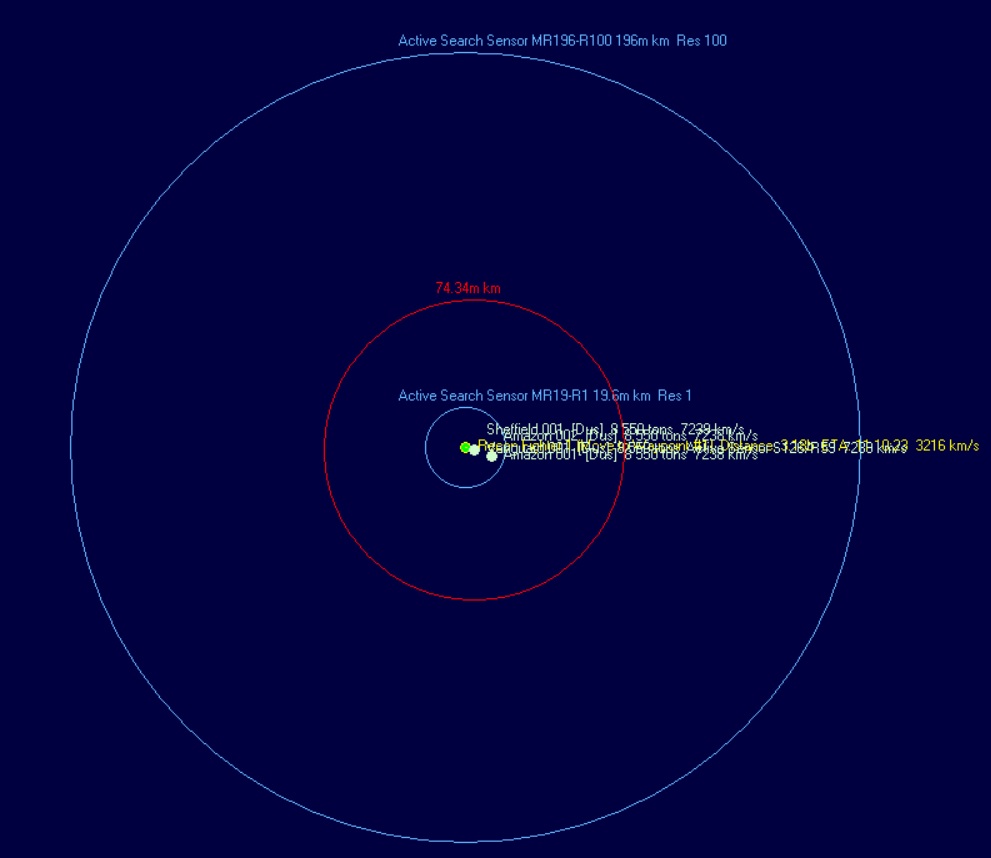
At January 22nd, 20:50:46 the recon fighters are hit by 3 missiles. Based on their flight patterns they are theorized to be anti-ship missiles, but since they were launched at point blank range it is hard to say for sure. Each missile caused a strength 13 nuclear explosion. 15 crew make it to the lifepods and are stranded in Dusseldorf with no hope for rescue.

When news about the destruction of the recon fighters reaches Earth construction and research priorities are switched to war mode. Meyer Werft which has been building the gate builders is converted to the Lastesel-class heavy transport since wrecks might prove to treasure trove of important technologies and to move PDCs away from Earth.
All ships in Bremen are ordered into the Koln System to start surveys there, the most important point is trying to prevent the Hannover jump point from looking like the origin of Earth ships. Maybe the impression can be established that Humanity comes from the Koln System, even though it is very likely that the aliens have already surveyed Koln. Kepler 3 volunteers to stay at the Bremen/Dusseldorf jump point and look for an alien transit.
Due to the range advantage the Dusseldorf Aliens better sensors are a high priority. With improved sensor tech expected to be 3 years away from completion larger sensors seem to be the only way in the short term. A size 10 sensor able to spot 5kt ships would have a range of close to 400mkm and take about 3 month to develop. Improving the planetary sensor network would take about the same time. Both projects are started, but first research into better beam fire control tech will have to be completed in order to build a beam PD fighter/FAC.

Industrial capacity will be focused on Ordnance Production Factories and Fighter Production Factories for now. But currently missile technology is hardly known, this has to be remedied soon. In mid February all components for a railgun based fighter are completed and production of the Fokker R1 is started.
Fokker R1 class Fighter 500 tons 17 Crew 96.6 BP TCS 10 TH 64 EM 0
6400 km/s Armour 1-5 Shields 0-0 Sensors 1/1/0/0 Damage Control Rating 0 PPV 3
Maint Life 3.59 Years MSP 12 AFR 20% IFR 0.3% 1YR 1 5YR 22 Max Repair 20 MSP
Intended Deployment Time: 5 months Spare Berths 0
EP1 FC08 1HS 16 EP Magneto-plasma Drive (4) Power 16 Fuel Use 79.2% Signature 16 Exp 10%
Fuel Capacity 30 000 Litres Range 13.6 billion km (24 days at full power)
10cm Railgun V4/C3 (1x4) Range 40 000km TS: 6400 km/s Power 3-3 RM 4 ROF 5 1 1 1 1 0 0 0 0 0 0
Fire Control S00.5 48-2000 (FTR) (1) Max Range: 96 000 km TS: 8000 km/s 90 79 69 58 48 38 27 17 6 0
Stellarator Fusion Reactor Technology PB-1 (1) Total Power Output 3 Armour 0 Exp 5%
This design is classed as a Fighter for production, combat and maintenance purposes
On March, 7th the Heidi Baum GeoTeam completes its survey of New Berlin, revealing additional Sorium desposists and a 14.8mt Corundium Deposit @0.9. Overall still sadly hard to mine the bulk of the minerals.
A couple of days later the first Fokker R1 is completed and heads heads towards New Berlin in order to provide some protection. Taskforce Carrier 1 is ordered there as well to provide some logistical support for the fighters.
On March, 19th a population of a new race of aliens is detected at Koln A-III, it has a thermal signature of 4.9k and an EM emission of 49k while Earth has 35k/170k. Either this civilization is fairly backwards or this is a minor colony. Newly established Diplomacy Team Ulrich Bodendorf tries to establish communication.
Communication with the Koln aliens is established less than one week after initial contact. They identify themselves as the Iroquois Imperium and seem to be fairly peaceful, but it will take some time to work out a deeper translation of their language. At first sight they seem to be a race of heavily enhanced man-machines.
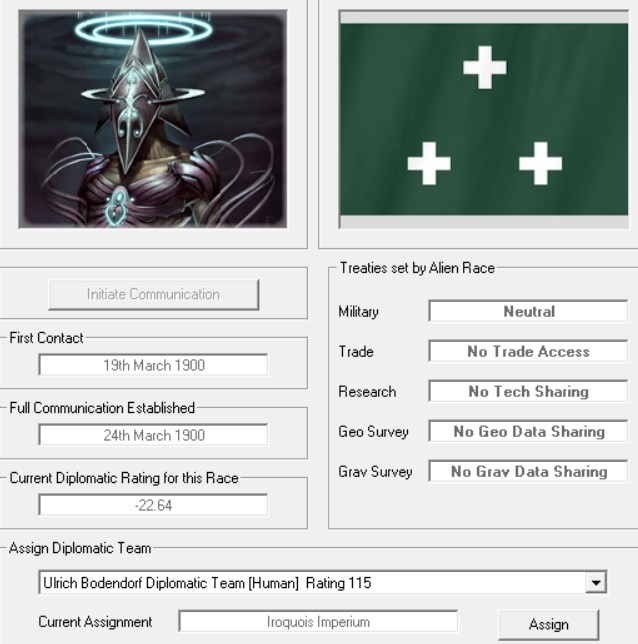
With the second Fokker arriving at New Berlin the population feel more secure, unrest is no longer rising. And construction on Earth is switched to Financial Industries, since those do not need any Duranium and might become useful later on.
In June the Duranium stpckpile has stabilized and is back above 1kt. The new FAC sensor ship is designed and a shipyard is retooled. In September Box-Launcher research is expected to be completed. A new FAC based on those launchers is planned. With the Dusseldorf aliens not having left their system there is some hope that it might be possible to bring the fight to them. Humanity still burns for revenge.
[/code]
Radar FAC R100 class Scout 1 000 tons 27 Crew 370.8 BP TCS 20 TH 80 EM 0
4000 km/s Armour 1-8 Shields 0-0 Sensors 1/1/0/0 Damage Control Rating 0 PPV 0
Maint Life 1.02 Years MSP 46 AFR 40% IFR 0.6% 1YR 44 5YR 667 Max Repair 280 MSP
Intended Deployment Time: 3 months Spare Berths 0
EP10 FC 08 25HS 80 EP Magneto-plasma Drive (1) Power 80 Fuel Use 76% Signature 80 Exp 10%
Fuel Capacity 140 000 Litres Range 33.2 billion km (95 days at full power)
Active Search Sensor MR392-R100 (1) GPS 28000 Range 392.0m km Resolution 100
This design is classed as a Military Vessel for maintenance purposes
In mid June an already established jump gate is found in Koln, it is located close to 5bkm from Koln-A at a angle of 310°. Kepler 5 heads there to investigate. A short time later the final GravSurvey is conducted and no further jump point was found. The first Seekuh tanker arrives at New Berlin from Earth, a second delivery is ordered, this will greatly cut down on the overhead needed to keep the survey ships in operation.
Kepler 5 jumps into the Nurnberg System, which consist of a small M-class sun (7% mass) and 2 planets. Due to the weak radiation from Nurnberg-A no life is possible there. The survey ships start to explore the system. And as expected, there is a gate at the Nurnberg-side as well. But it seems very unlikely that the Iroquois came from Nurnberg, most likely there is another gate in Nurnberg.
With the Duranium stockpile still rising retooling for the Kondor Mk2 carrier is started. At the beginning of August a ungated jump point is found in Nurnberg. It is located about 1.5bkm from Nurnberg-A at an angle of 350°. The JP leads into an equally boring system, Stuttgart. It consists of a single K-class sun and a single terrestrial planet orbiting it, due to the closeness to the sun the planet is very hot and seems uninhabitable. Another jump point is found in Nurnberg again without a gate, this one about 1.8bkm away from the sun at an angle of 135°. Kepler 3 heads there from New Berlin.
With no further jump points found in Nurnberg is seems very likely now that the Iroquois are not a very technically advanced race, which found fit in with the fairly low emissions from their planet and the lack of space ships or space stations as well.
The final Nurnberg jump point leads to the Mannheim System, consisting of 2 G-Class sun (around 90% mass) with Mannheim-B orbiting A at a distance of 0.1 lightyears. Mannheim-B has 6 planets with a fair number of moons, but due to the distance it is hard to make out any details. Mannheim-A has 9 planets with Mannheim A-III to V being in the habitable zone as well as being terrestrial planets. Further investigation might yield interesting results. In addition to the planets there are about 30 moons and 25 asteroids. With the JP more than 3bkm from the inner planets and due to the distances involved to reach Mannheim it will take some time before a large scale survey can be launched.
A missile fire control is tailor made for the Dusseldorf aliens (resolution 8kt for their 8.55kt ships) in addition to a size 6 box launcher. Speed is somewhat below what was seen from the aliens, but it is hoped that the missile range will be high enough to enable a timely retreat. A size 6 ASM is designed for the launcher/control combo as well. Since the enemy has been firing AAMs with a strength warhead the idea is using a large number of fairly small warheaded missiles from long range instead of large warheads. Retooling a shipyard and production of the missiles is begun. The next generation of carriers will have to incorporate magazins in order to reload the missile boats.
Falke class Missile Boat 1 000 tons 12 Crew 151.2 BP TCS 20 TH 144 EM 0
7200 km/s Armour 1-8 Shields 0-0 Sensors 1/1/0/0 Damage Control Rating 0 PPV 8.1
Maint Life 1.52 Years MSP 9 AFR 80% IFR 1.1% 1YR 4 5YR 66 Max Repair 28 MSP
Intended Deployment Time: 1.9 months Spare Berths 0
Magazine 54
EP1 FC08 1HS 16 EP Magneto-plasma Drive (9) Power 16 Fuel Use 79.2% Signature 16 Exp 10%
Fuel Capacity 20 000 Litres Range 4.5 billion km (7 days at full power)
Size 6 Box Launcher (9) Missile Size 6 Hangar Reload 45 minutes MF Reload 7.5 hours
Missile Fire Control FC148-R160 (1) Range 148.7m km Resolution 160
Size 6 Anti-ship Missile (9) Speed: 25 600 km/s End: 89.6m Range: 137.6m km WH: 4 Size: 6 TH: 136/82/41
Missile to hit chances are vs targets moving at 3000 km/s, 5000 km/s and 10,000 km/s
This design is classed as a Military Vessel for maintenance purposes
In November the first Lastesel transport is completed. Together with a Geier salvager it heads off into the Munchen system to salvage the 2 wrecks there. Followed shortly afterwards by another transport/salvager pair.
In early December a jump point is found in Stuttgart. It is located about 400mkm from the sun at an angle of 200°. Kepler 2 moves to investigate. The JP leads to the Dresden System, which has a single G-class sun (108% mass). There are 6 planets, about 60 moons and a couple of asteroids. There is one terrestrial planet inside the habitable zone which looks interesting.
A new jump point is found a Stuttgart a short while later. About 1bkm from the sun at 105°. Kepler 4 moves to investigate.
Map at the end of 1900
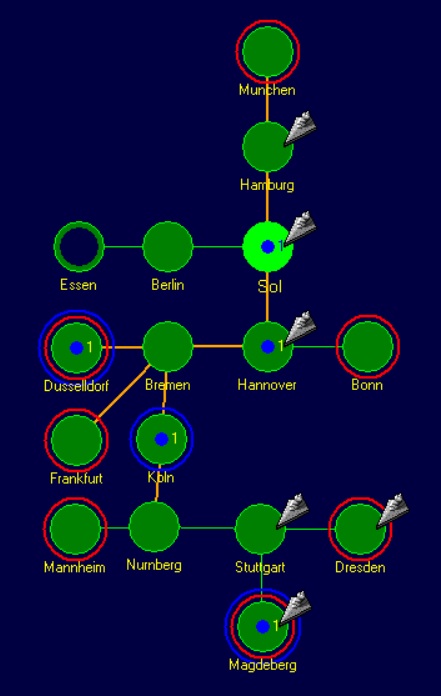
That’s it for today…
edit: Research table was from 10 years ago
